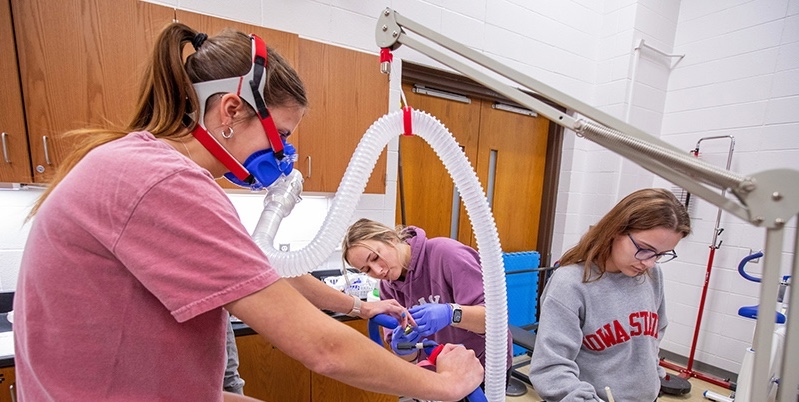Assessment of academic programs ensures that Iowa State University is providing excellence in all academic areas. Iowa State University goes through accreditation and program review processes on a regular basis to ensure excellence in program quality.
Accreditation and Academic Program Review

Accreditation
Iowa State University is accredited by the Higher Learning Commission.
As a part of the normal Open Pathway accreditation process with the Higher Learning Commission (HLC), Iowa State University successfully navigated its “Year 4 Assurance Review” in February 2020. This review was conducted by a team of peer reviewers who reviewed an updated version of Iowa State University’s Assurance Argument prepared as a part of the Higher Learning Commission Comprehensive Review that occurred during 2015-2016. We thank the members of our 2019-2020 HLC Steering Committee as well as the peer reviewer team for their outstanding work.
From Spring 2021 through Spring 2022, Iowa State commenced work on an 18 month Quality Improvement Initiative, which was approved by HLC on April 13, 2021. Recommendations from the ACE Learner Success Lab project will guide university efforts to further student success and to prepare for the 2025 HLC reaccreditation review.
Questions regarding Iowa State University’s accreditation status may be directed to Kelsey Gillen, Director of Academic Quality and Undergraduate Education, at kmgillen@iastate.edu.
As a part of the normal Open Pathway accreditation process with the Higher Learning Commission (HLC), Iowa State University completed its “Year 4 Assurance Review” in Spring 2020. The HLC review team reviewed an updated version of the Assurance Argument that was prepared as a part of the Higher Learning Commission Comprehensive Review that occurred during 2015-2016.
The 2019-2020 HLC Steering Committee included the following members:
- Surya Mallapragada, Associate Vice President of Research
- Sara Marcketti, Director of Center for Excellence in Learning and Teaching
- Matt Pistilli, Division of Student Affairs
- Ellen Rasmussen, Division of Finance and University Services
- Rob Schweers, Director of Communications, Office of the Senior Vice President and Provost
- Brad Skaar, Associate Professor, Animal Science, Higher Learning Commission Peer Reviewer
- Amy Slagell, Associate Dean, College of Liberal Arts and Sciences
- Ann Marie VanDerZanden, Associate Provost for Academic Programs
- Courtney Vengrin, Adjunct Assistant Professor, College of Veterinary Medicine, Chair of Faculty Senate Outcomes Assessment Committee
- Karen Zunkel, Director of Academic Quality and Undergraduate Education, Office of the Senior Vice President and Provost, Steering Committee Chair
Iowa State University prepared for a November 2-3, 2015, accreditation visit by the Higher Learning Commission (HLC). Iowa State participated in the HLC Open Pathway accreditation process that includes four major components:
- Submission of a report on the HLC required Quality Initiative that Iowa State selected to pursue related to the systematic collection and use of graduate first-destination information (PDF).
- Submission of an Assurance Document (and related evidence) that documents how Iowa State is meeting the Criteria for Accreditation established by HLC.
- Submission of materials to demonstrate the institution’s compliance with certain Federal Requirements (see below).
- An on-site visit by HLC peer reviewers on November 2-3, 2015.
Compliance with Federal Requirements
As a part of the accreditation process, Iowa State University must submit information (that will also be verified during the site visit) that it is in compliance with Federal requirements in the following areas:
- Assignment of Credits, Program Length, and Tuition (includes a review of sampled syllabi during site visit)
- Institutional Records of Student Complaints (includes a review of student complaint logs during site visit)
- Publication of Transfer Policies
- Practices for Verification of Student Identity
- Title IV Program Responsibilities
- Required Information for Students and the Public
- Advertising and Recruitment Materials and Other Public Information
- Review of Student Outcome Data
- Standing with State and Other Accrediting Agencies
- Public Notification of Opportunity to Comment
Complete details of the Federal Compliance Requirement are available from the HLC website.
In addition, numerous Iowa State University programs are accredited by specialized accrediting agencies (PDF).
Academic Program Review
Per Iowa Board of Regents policy, academic programs undergo a program review every seven years. The Office of the Senior Vice President and Provost coordinates the scheduling of reviews with the academic colleges. See information on the process, timelines, and reporting expectations.